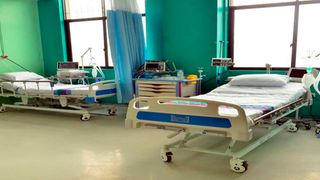
Some of the beds at the Infectious Disease Unit (IDU) and Intensive Care Unit (ICU) of the Kenyatta University Teaching Referral and Research Hospital (KUTRRH).
| File | Nation Media GroupNews
Premium
Ray of hope as more ICU beds available
What you need to know:
- In a report published in October last year, the Kenya Medical Practitioners and Dentists Council identified 492 ICU beds nationally.
- The Covid-19 country preparedness and response performance report also identified 13,000 isolation beds.
More intensive care unit (ICU) beds are available across the country, suggesting recovery of critically ill patients over the past week.
Counties said the number of ICU beds dedicated to Covid-19 patients increased by 78 to 360 this week – from 282 last week.
The number of available high dependency unit (HDU) beds also increased to 123 from 101 last week.
And some 6,345 isolation beds are now available, an increase of 313 “as a result of patients who have recovered from Covid-19”, said Council of Governors chairperson Martin Wambora.
In a report published in October last year, the Kenya Medical Practitioners and Dentists Council identified 492 ICU beds nationally.
The Covid-19 country preparedness and response performance report also identified 13,000 isolation beds.
However, the country still faces a challenge with regard to ICU bed capacity.
In April last year, a month after the coronavirus struck, there were only 518 ICU beds in both public and private facilities in Kenya, according to a report by the Senate Ad Hoc Committee on the Covid-19 situation.
At the time, 448 of the 518 ICU beds were already in use by other patients who required critical care services.
Critically ill Covid-19 patients
In the past one week, Mr Wambora noted, the number of Covid-19 patients admitted to ICU and HDU facilities has decreased significantly.
“This can be attributed to adherence to the guidelines issued by the Ministry of Health on home-based care,” explained Mr Wambora, who is also the Embu governor.
Figures from the daily briefing by the Ministry of Health also show a slight reduction in the number of the critically ill Covid-19 patients.
In the week leading up to May 8, the number of patients in ICU was 117, 119, 128, 134, 133 and 131.
Those in HDU over the same period were between five and eight.
The number of coronavirus patients in hospitals across the country has also slightly reduced.
In the week to May 8, the figures were 1,021, 1,049, 1,105, 1,122, 1,099 and 1,103.
Home-based care also marked a positive trend as the cases also declined compared to the previous weeks’ records.
Data from 24 counties showed at least 1,165 patients were under home-based isolation, a figure the CoG said had declined compared to the past weeks.
Patients in ICUs
Covid-19 patients with little or no symptoms were urged to go for the home-based care option to free isolation facilities to those in critical condition.
The Covid-19 situation appears to be improving since March, when President Kenyatta imposed stricter restrictions as infections surged.
Since the last address on March 12, the President noted, more than 950 Kenyans had been admitted to ICU wards with Covid-related complications.
This was a worrying situation given that in January, an average of 20 patients were in ICUs and on oxygen. The number rose to just under 30 in February.
By March 21, the number of confirmed Covid-19 cases had shot up to 15,916 from 4,380 in January. The positivity rate had risen to 22 per cent from 2.6 per cent in January.
On May 1, however, the President eased some of the restrictions, citing a 72 per cent fall in caseload within the zoned area – Nairobi, Kiambu, Kajiado, Machakos and Nakuru.
The President further noted the caseload had fallen in other places, citing a fall of 89 per cent in Mombasa and 90 per cent in Busia between March and April 2021.
So far, a total of 917,068 doses of the vaccine have been administered across the 47 counties.
Mr Wambora revealed 160,947 healthcare workers had been vaccinated. Another 77,417 doses, he added, had been administered to the security personnel, 143,684 to teachers, another 280,876 to those aged above 58 years and 254,144 administered to other Kenyans.
Rapid transmission of virus
The governors have appealed to the national government to rescind its decision of recalling Covid-19 vaccine doses from counties with low uptake of the jabs.
Counties that had been cited as having low uptake included Kwale, Samburu, Mandera, Garissa, Wajir, Isiolo, Tana River and Lamu.
“We have analysed the consumption of the deployed vaccines and found that the number of unused doses is quite low and therefore counties will be able to utilise the vaccines before the end of their shelf life,” Governor Wambora said.
Players in the Education sector were called upon to be vigilant in order to keep teachers and learners safe.
To support the sector, the CoG distributed 1.1 million face masks to learners in public ECDE centres and vocational training centres.
An additional 9,341 portable hand-washing stations with soap and running water were also set up in learning institutions across the country as well as posters “to remind learners on proper usage of masks and hand-washing techniques”, Governor Wambora said.
“Frequent fumigation of common areas and learning stations will also be conducted,” he added.
The governors warned that the transport sector, especially public service vehicles, still pose a key risk in rapid transmission of the virus.
“In light of the reopening of schools, we urge the matatu sector to ensure adherence to the limit on the number of passengers aboard PSVs,” the CoG chairperson said.
Preventive measures
He also called on county transport safety committees to ensure health screening is undertaken within transport corridors.
This, he said, was essential especially after the deadly Indian variant of the virus had been detected in Kenya.
The governor revealed that tracing of those who had interacted with the first identified cases of the Indian variant was almost complete and that at least 70 people had been successfully traced.
“We urge the national government not to lock down the counties again even with the cases of the new Indian variant considering the impact the last lockdown had on the economy. Instead, we should focus on preventive measures,” he said.
Counties along the borders were urged to keenly monitor any person coming in and going out of the country. The Ministry of Health was called upon to facilitate border counties such as Busia, Migori and Kajiado, which are heavily used by the neighbouring countries for trade purposes.
“Tests must be conducted for anyone coming in or going out of the country. We have to be alert now more than ever,” the CoG chairperson said.
To bolster their response to the pandemic, governors want the outstanding debt of Sh66 billion owed to the counties by the National Treasury released as soon as possible. Sh2.6 billion is owed to Nairobi County for the months of December 2020 and January this year.
Another Sh10 billion is still owed to 22 counties for the month of February and an extra Sh25 billion and Sh28 billion owed to all 47 counties for the months of March and April respectively.
"We, therefore, call upon the National Treasury to expedite the release of these funds to allow county governments enhance their response measures, pay their pending bills and develop the counties," Governor Wambora concluded.





